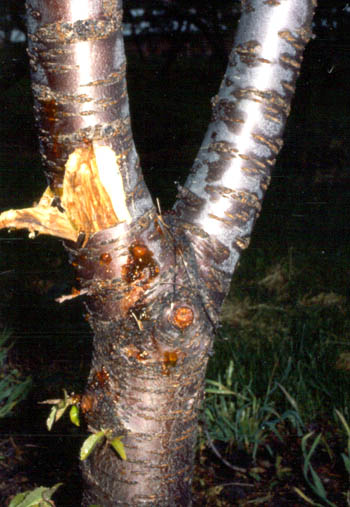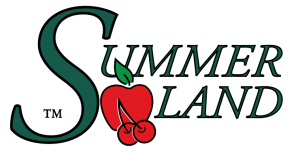Bacterial Canker of Stone Fruits
General Description
Bacterial canker is a common disease of stone fruit in British Columbia. It is most damaging under wet climate conditions, but has been an increasing problem in young cherry orchards in the B.C. Interior. The disease is caused by the bacterium Pseudomonas syringae. Cherries are very susceptible, but Psuedomonas also infects other stone fruit, pears, apple rootstocks and many species of ornamental trees. Young cherry trees are more susceptible than established cherry trees, and trees under stress are much more susceptible than healthy trees with optimal growing conditions. Outbreaks are often associated with prolonged periods of cold, wet weather with late spring frosts.
Symptoms
Symptoms on young cherry trees include dead buds and elongated cankers that are soft or spongy to the touch and gumming copiously. Cankers may expand rapidly in the spring causing girdling of the main trunk or branches. Bacterial canker may also cause brown, circular spots on leaves which fall out to give a "shothole" symptom. Fruit lesions include small, brown, slightly sunken lesions on immature fruit. Leaf and fruit symptoms are not common in the Okanagan, but may be seen in areas with higher rainfall.
Laboratory diagnosis should be done in the spring as the bacterium is difficult to isolate once hot summer weather arrives.
.jpg) |
 |
| Bacterial canker of cherry showing gumming (AAFC) |
Bacterial canker on cherry. Note discolouration of wood and gumming. (AAFC) |
Life Cycle
Pseudomonas overwinters in canker margins, in healthy buds and also systemically in the vascular system. In the spring, bacteria are disseminated by rain to buds, blossoms, young leaves and developing fruit. The bacteria can survive in an epiphytic phase on the surface of symptomless leaves and blossoms, and also on other plants or weeds in the orchard during the summer.
Infection is known to occur in leaf scars in the autumn, and in all types of natural and man-made injuries to the tree, including pruning wounds, heading cuts, scoring cuts, frost injury, and winter injury. Most infections are thought to take place in the spring and fall during cool, wet weather. However infection can occur during the summer if temperatures are not too extreme and weather is wet.
Research in Oregon has shown that infection of heading cuts resulted in the highest tree mortality, followed by infection of leaf scars and summer pruning. In comparison, freezing injury, low temperature injury and dormant pruning resulted in the lowest canker incidence and severity.
Management
Cultural Control
-
Minimize stress on young or recently planted cherry trees, as it is a major predisposing factor. For example, provide adequate water to prevent drought stress; avoid planting in areas with poor drainage or high frost potential; supply optimal levels of nutrients; check soil pH; and control other pest and disease problems that may weaken trees.
-
Remove severely affected trees and prune off dead or dying branches.
-
Summer prune during dry weather only. Similarly scoring and heading cuts should be made in dry weather, with no rain in the forecast. Avoid pruning in early spring and fall when bacteria are most active.
-
Don't let weeds grow up around the trees. They cause unnecessary stress by competing for moisture and nutrients, increase humidity, and may harbour populations of the bacteria that cause canker.
-
Trees with minor gumming may recover. Cankers may heal if the tree is able to contain the canker with callus tissue. Small cankers may also be cut out with a sharp knife, being careful to disinfect cutting tools between trees.
-
The F12-1 Mazzard rootstock is reported to be resistant. If propagating cherry, use only scions from virus-free, canker-free trees.
-
Before establishing new orchards, have soil tested for pathogenic nematodes. High nematode populations, particularly the ‘ring nematode’ are associated with increased losses due to bacterial canker. Fumigate soil before planting if nematode populations are high.
Chemical Control
Kasumin (kasugamycin) is a bactericide registered for suppression of bacterial canker and control of blossom blast caused by Pseudomonas. Begin applications at early bloom. Repeat at 7 day intervals, with a maximum of 4 applications per year. Do not use within 30 days of harvest.
Copper Spray (copper oxychloride) or Cueva (copper octanoate) may be used in the fall to protect leaf scars, and in early spring before bloom, however the effectiveness of copper is questionable due to resistance issues. Copper resistance in populations of Pseudomonas syringae is widespread in the Pacific Northwest in orchards and nurseries with a history of copper use. It is not known to what extent copper-resistant strains are present in B.C. Copper sprays are no longer recommended in some areas with resistance, as their use can actually increase damage due to bacterial canker, likely by suppressing beneficial organisms that compete with Pseudomonas.
Updated December, 2016
